

Exploring our past to sort out myth from reality
Share this Page on
Facebook or Twitter

These are the voyages of the TimeShip Anachron.
Our Mission: To boldly explore the past, dispelling
mythinformation and mythconceptions
of American History along the way.
 Visit us on Facebook
Visit us on Facebook
Meet MythAmerica SNAPSHOT
Stone Mountain and the KKK
Stone Mountain, Georgia is in the news right now, as the state of Georgia has decided to erect a monument to Martin Luther King, Jr., on the grounds of this major Georgia tourist attraction. This is stirring up quite a controversy, as Stone Mountain is already the site of the largest Confederate War Memorial stone carving in the world. Some news reports don't seem to address one of the most poignant aspects of this choice of location. The emphasis in the news seems to be on the juxtaposition of Martin Luther King, Jr., and Robert E. Lee and associates. No, that isn't the prime poignancy of this choice of location. Long before Stone Mountain became known for that huge carving of the Confederate generals, it was famous for something else.
1934, from the Sandusky, Ohio paper:
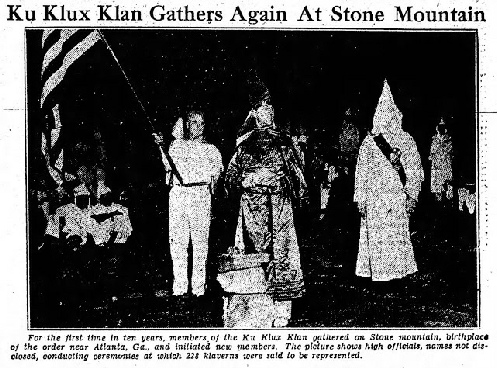
"Gathers Again" says the headline. Just what did that mean? Therein lies a piece of history you need to know, in order to clearly understand some of the issues making the headlines today.
For those unaware...there was a group called the Ku Klux Klan that arose in the South at the end of the Civil War. It was neither the Klan of the 1920s, which was a second incarnation of the name, nor the Klan of the 21st century, which is a third incarnation of the name.
The first Klan was founded in 1865 in Pulaski, Tennessee, by six veterans of the Confederate Army. The name is probably derived from the Greek word kuklos (κύκλος) which means circle.
Although there was little organizational structure above the local level, similar groups rose across the South and adopted the same name and methods. Klan groups spread throughout the South as an insurgent movement during the Reconstruction era in the United States. As a secret vigilante group, the Klan targeted freedmen and their allies; it sought to restore white supremacy by threats and violence, including murder, against black and white Republicans. In 1870 and 1871, the federal government passed the Force Acts, which were used to prosecute Klan crimes. Prosecution of Klan crimes and enforcement of the Force Acts suppressed Klan activity. {Wiki: KKK]
And thus the Klan of that era sort of “disappeared from history” except as a dim memory for most people. For about thirty years.
Then in 1905 author Thomas W Dixon Jr. resurrected the glorious memory of the 19th century Klan in his novel The Clansman: An Historical Romance of the Ku Klux Klan.
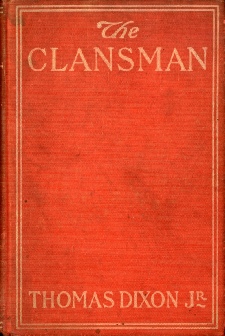
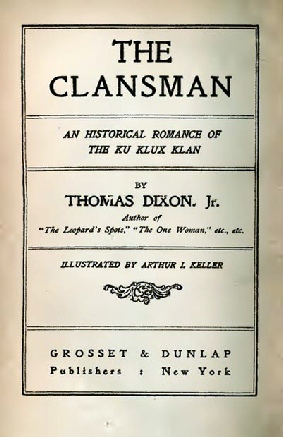
Immediately after publication, Dixon turned it into a stage play, and both book and play, but particularly the play, took much of the nation by storm, including productions in Los Angeles:
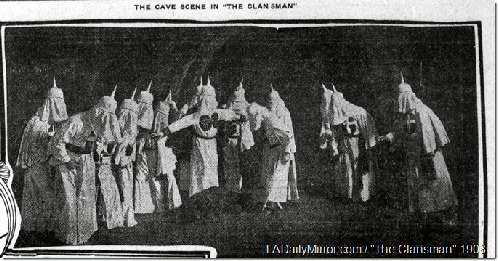
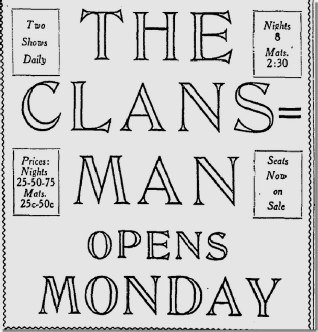
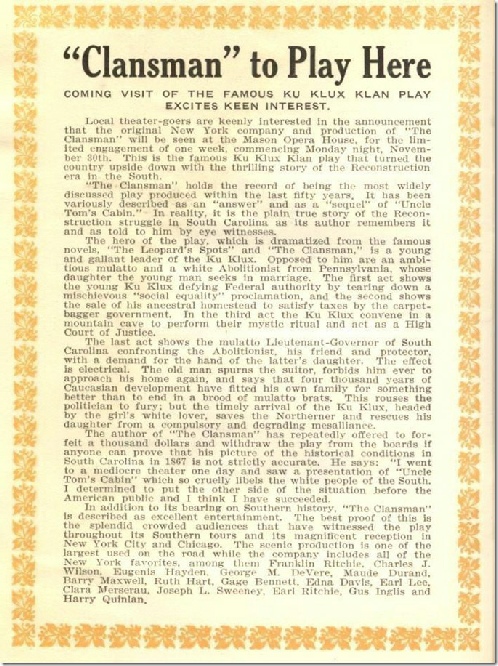
Dixon, born in Shelby, North Carolina in 1864, was a “Southern Baptist minister, playwright, lecturer, North Carolina state legislator, lawyer, and author.”
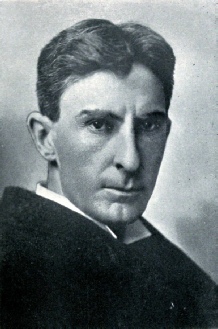
A brilliant student, he earned a master’s degree in history and political science at age 18 in 1883. While a grad student in political science at John’s Hopkins University in 1884, he became a friend of future US president Woodrow Wilson, who was also studying for a graduate degree in political science at the University.
Dixon wrote fiction, but he based much of his novel on memories from his childhood, during the period of Reconstruction.
Dixon claimed that one of his earliest memories was of a woman who pleaded for his family's help. She was the widow of a Confederate soldier who served under Dixon's uncle, Col. Leroy McAfee. She claimed that a black man had raped her daughter. That night the Ku Klux Klan hanged and repeatedly shot the alleged rapist in the town square. Dixon's mother commented to him that "The Klan are our people—they're guarding us from harm." It was a moment that etched itself into Dixon's memory; he felt that the Klan's actions were justified, and that desperate times called for desperate measures.
Dixon's father, Thomas Dixon, Sr., and his uncle Leroy McAfee, both joined the Ku Klux Klan early in its history with the aim of "bringing order" to the tumultuous times, and Col. McAfee even attained the rank of Chief of the Klan of the Piedmont area of North Carolina. But, after witnessing the corruption and scandal involved in the Klan they would both dissolve their affiliation with the group and attempt to disband it within their region. [Wiki: Dixon]
But in spite of this “later outcome,” Dixon never seemed to let go of his admiration for the Klan, and built a grand and glorious mythology around it in his writing.

There were no doubt terrible injustices committed by individuals and groups of both the North and the South during the period of Reconstruction, but you’d never know that from a reading of The Clansman. There is no hint in the book and play that the Klan was ever anything but an entirely noble Savior of the White man and woman of the South.
In The Clansman, Reconstruction was an attempt by Augustus Stoneman, a thinly veiled reference to Thaddeus Stevens, to ensure that the Republican Party would stay in power by securing the southern black vote. His hatred for President Johnson stems from Johnson's refusal to disenfranchise whites. Stoneman's anger towards former slave holders is intensified after the assassination of Abraham Lincoln, where he vows revenge on the South. His programs strip away the property owned by whites, in turn giving them to former slaves. Men claiming to represent the government confiscate the material wealth of the South, destroying plantation owning families. Finally, the former slaves are taught that they are superior to their former owners and should rise up against them. These injustices are the impetuses for the creation of the Klan.
…The release of the movie The Birth of a Nation [see the description of this below] finally let Dixon's work reach a large enough audience to start the refounding of the Klan. This second Klan quickly outgrew the first, drawing significant membership from Northern states in part because of the success of the novel, play, and movie. The social impact of the book was certainly enormous. Though Anglo-
DW Griffith’s classic movie, the first real “Blockbuster” in movie history, brought Dixon’s written words to splendiferous life.
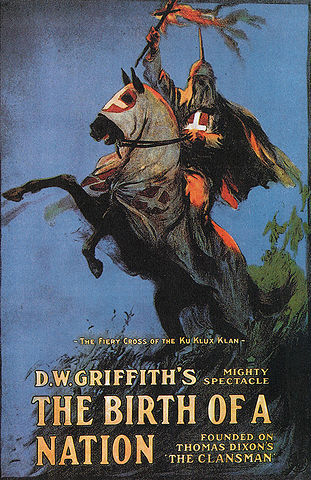
The Birth of a Nation began filming in 1914 and pioneered such camera techniques as the use of panoramic long shots, the iris effects, still-
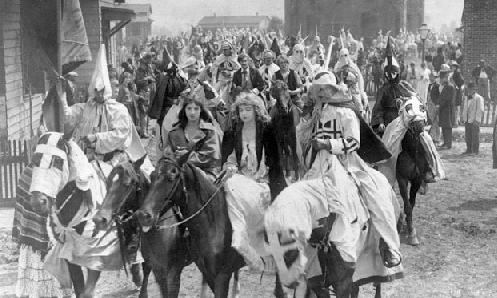

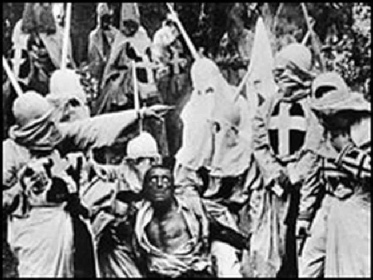
When the film was released, it shattered both box office and film-
And it soon swept the nation, from Baltimore, Maryland…
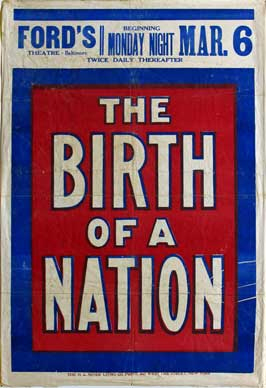
...to New York City...
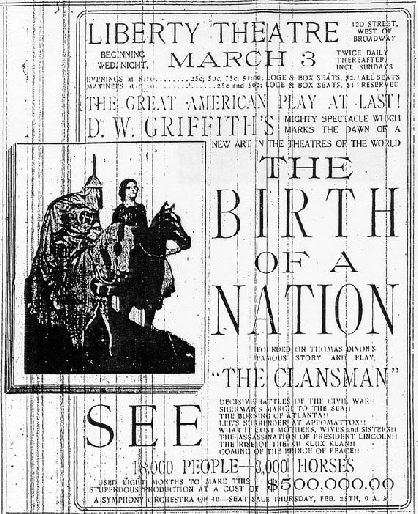
…to Appleton, Wisconsin…
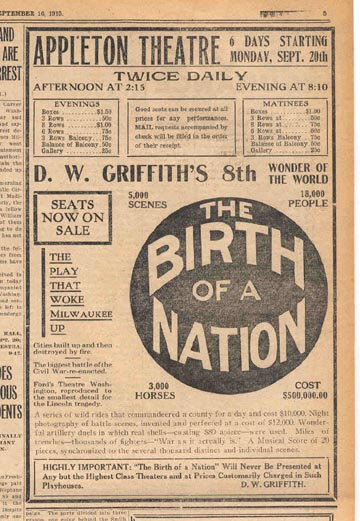
…to Wichita, Kansas…
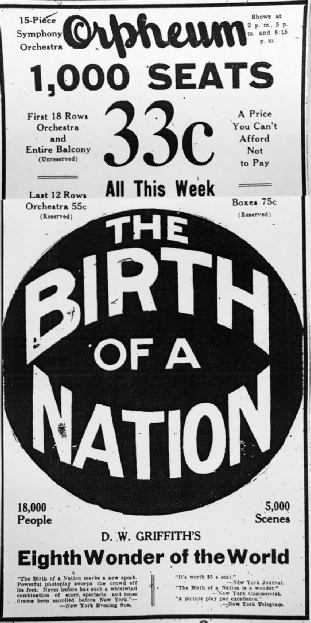
…to Seattle, Washington…
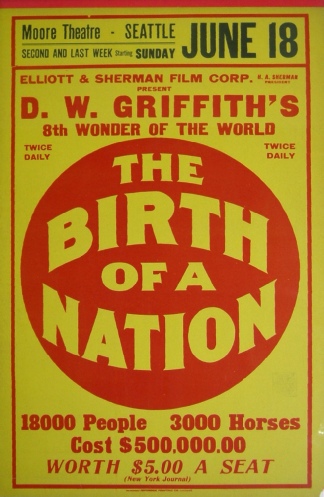
…and all points in between.
Including Portland. Oregon, as you can see from these newspaper ads in the Portland Oregonian from the summer of 1915.
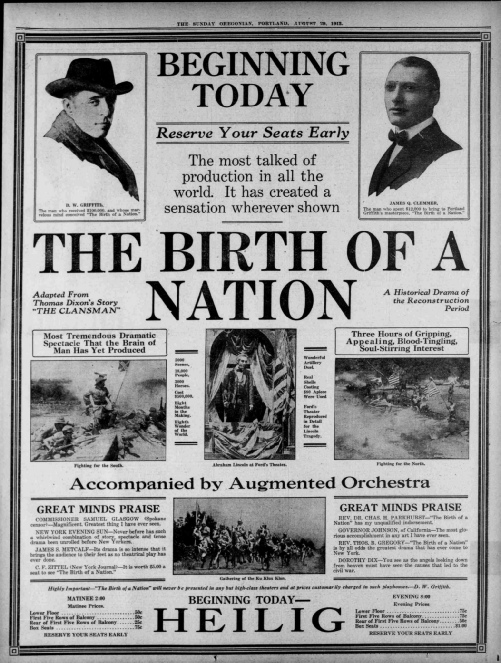
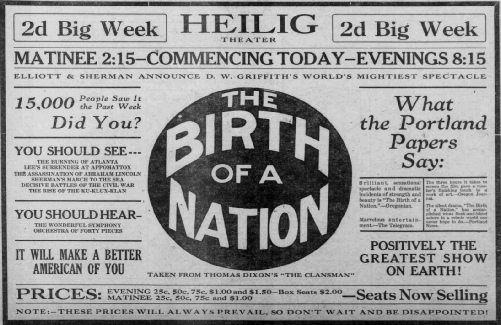
The first half of the film depicted the Civil War, and after an intermission, the second half dealt with the period of Reconstruction.
It is surprising to note that the film didn’t just have a “single run” like many films of the time. Years later it was still being shown in theaters to eager crowds. Even AFTER the advent of the “talkie.” Here’s a poster for the film from 1931, when a musical and sound effects sound track was added to it.
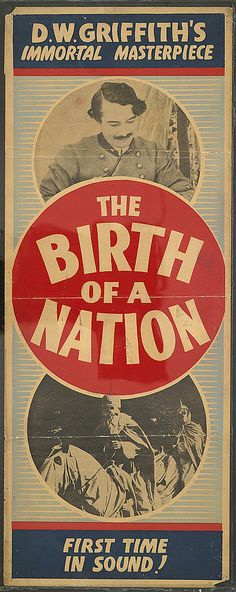
I have seen numerous references on the Internet to then-
…Thomas Dixon, Jr., author of the source play The Clansman, was a former classmate of Woodrow Wilson at Johns Hopkins University. Dixon arranged a screening at the White House for then-
In spite of whether Wilson approved or not, huge numbers of Americans did.
…The film is also credited as one of the events that inspired the formation of the "second era" Ku Klux Klan at Stone Mountain, Georgia, in the same year. The Birth of a Nation was used as a recruiting tool for the KKK. [ibid]
When I initially began researching the history of the KKK back in 2012, I happened to live in Rome, Georgia, just 85 miles from Stone Mountain. When we first moved to Georgia in 2007, I’d never even heard of “Stone Mountain,” although I had seen pictures in the past of the main tourist attraction that draws people to the location:
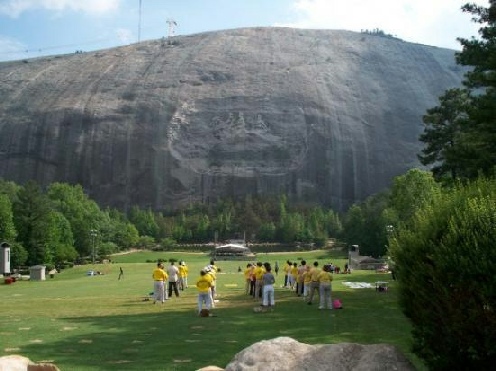
Look very closely…in this “wide view” of the attraction, you can’t really tell what that is, etched in the stone about half-
It is the largest bas-
The largest bas relief sculpture in the world, the Confederate Memorial Carving depicts three Confederate leaders of the Civil War, President Jefferson Davis and Generals Robert E. Lee and Thomas J. “Stonewall” Jackson (and their favorite horses, “Blackjack”, “Traveller”, and “Little Sorrel”, respectively). The entire carved surface measures 3 acres, about the size of two and a quarter football fields. The carving of the three men towers 400 feet above the ground, measures 90 by 190 feet, and is recessed 42 feet into the mountain. The deepest point of the carving is at Lee’s elbow, which is 12 feet to the mountain’s surface. [Wiki: Stone Mountain]
My family made a trek to visit Stone Mountain Park in early 2011. We found the carving itself is not too impressive, even when seen “in person,” because the mountain it is on is SO big and the carving is SO high up the mountain. But in photos and with the right lighting you can see it up close, and it is indeed pretty neat.
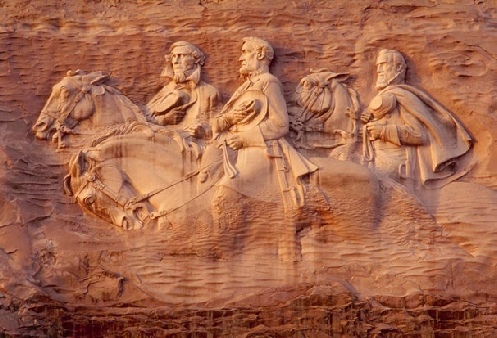
The Confederate Memorial carving was begun in 1922…but not finished…by Gutzon Borglum—the same sculptor who was responsible for the carvings of the presidential heads on Mt. Rushmore. (Borglum was a KKK member.) Not finished until 1972, the Confederate Memorial is now the centerpiece of a cheerful family fun park, complete with such activities as a cable car ride up the mountain; antebellum plantation with an area where you can pet sheep, goats, and pigs; children’s play barn area holding 65 games and slides and such; rock wall climbing and rope bridges; glass blower and other craft demonstrators; a totally out-
The Spectacular is a fireworks and laser light display, with huge iconic pictures and corny animations projected on the Mountain. And backed up by booming loudspeakers playing a mix of patriotic and Southern-
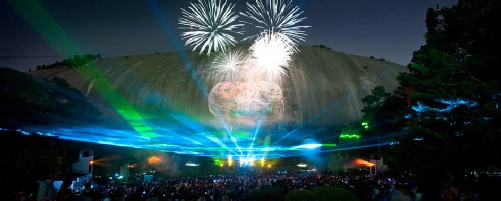
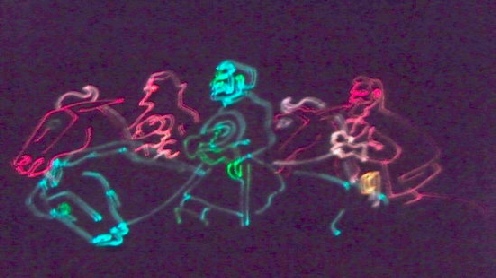
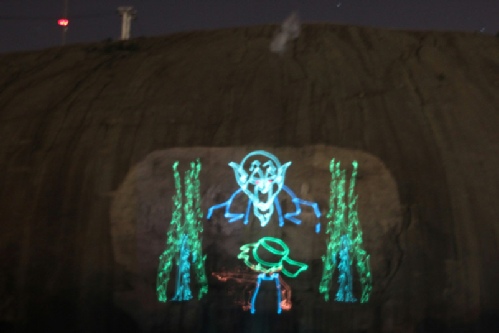
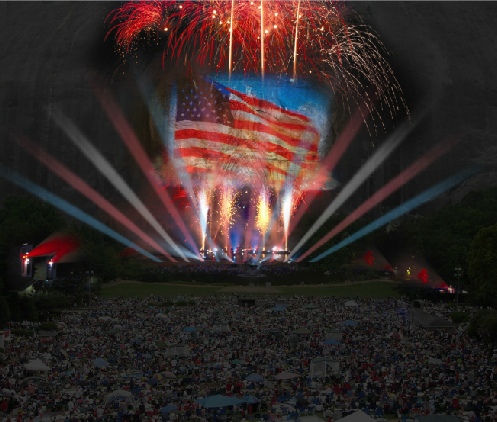
And, as the description on Wiki puts it, “pyrotechnics.”
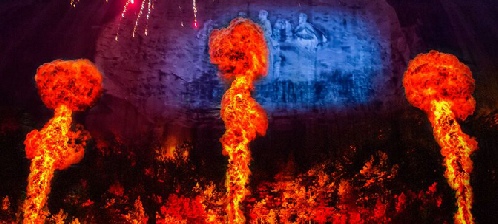
Our visit was over a year before I learned about the KKK/Stone Mountain connection. I would never have known about the connection from anything I saw that day in the various parts of the attraction or in material from the gift shop. The day we visited, the visitor’s history center was closed for renovations. But I’m going to guess that even if it was open, they would have downplayed the story of the first “pyrotechnics” on Stone Mountain, in 1915.
For right in the midst of the hoopla over the Birth of a Nation movie across the land, on the night of November 25, 1915, a group of robed, hooded men gathered for a ceremony on the top of Stone Mountain to bring back to life the Ku Klux Klan.
From the Atlanta Constitution, 11/28/1915:

Present were two elderly members of the “original” Klan of the 1800s. William J. Simmons declared himself the "Imperial Wizard" of the Invisible Empire.
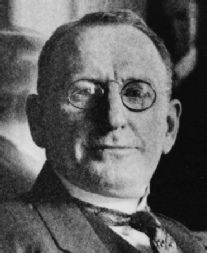
They all took an oath…and, of course, burned a cross.
In fact, such fiery pyrotechnics continued for many years at Stone Mountain. Here is a one minute clip of a group gathering at Stone Mountain in 1949.
As mentioned earlier, in 1915 and for some time to come, the Birth of a Nation was used as a “recruiting tool” for the New Klan, as it spread from that beginning at Stone Mountain across the US, reaching Oregon in 1921.
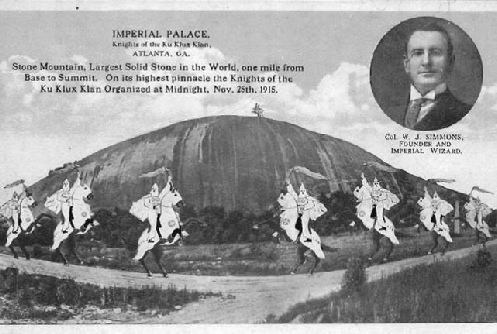
Over forty years later, In Martin Luther King’s “I Have a Dream” speech during the Civil Rights gathering at Washington DC in 1963, JUST before King gets to the “Free at last” finale, he mentions Stone Mountain! For obvious reasons…Stone Mountain is just barely outside the city limits of Atlanta, where King was born in 1929, grew up, went to school, and graduated from college. He would have been familiar throughout his life with the activities of the Klan and with cross burnings used to intimidate blacks and others. And at least in later years he no doubt was aware of the history of the relation between Stone Mountain and the Klan. As seen in these photos of Klan activity at Stone Mountain from news reports from the 1920s to the 1970s.
1920 from the Chicago Tribune
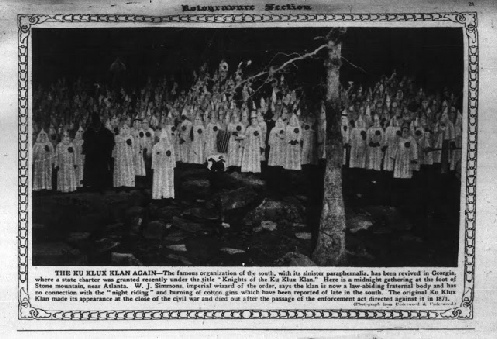
1922 from the New York Times
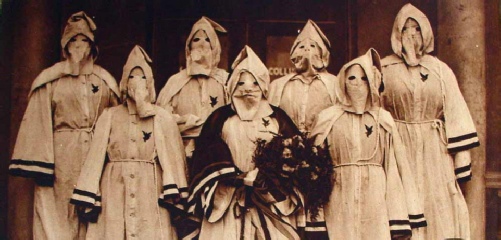
The caption that was on this photo in the newspaper:
“Members of a Possible ‘Women’s Auxiliary’ of the Klan: Group From the Five Hundred White Figures Which Recently Paraded at Night Through the Streets of Atlanta, Dressed Like the Men of the Ku Klux Klan, Saying They Represented a Secret Protestant Organization for Women Whose Officers Were Initiated on the Top of Stone Mountain,Where the Klan Was Organized.”
New York Times Rotogravure Picture Section, December 3, 1922
(From the American Newspaper Repository website)
1946 from TIME magazine
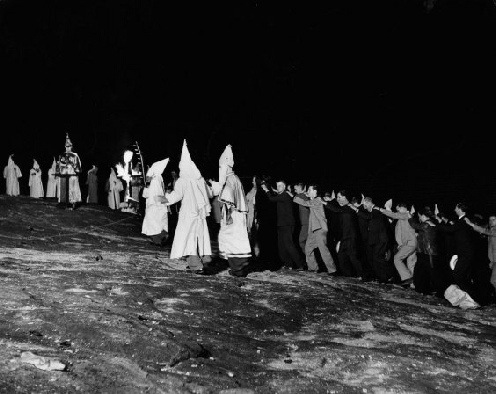
1948
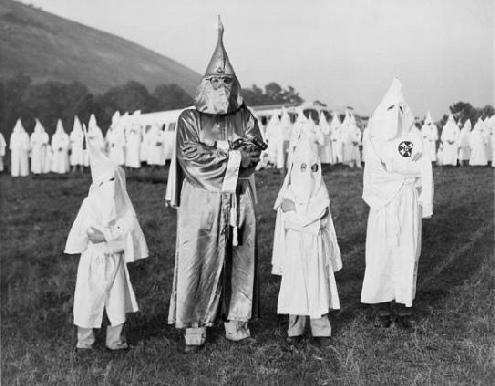 Dr. Samuel Green, a Ku Klux Klan Grand Dragon,
Dr. Samuel Green, a Ku Klux Klan Grand Dragon,
at Stone Mountain, Georgia on July 24, 1948,
flanked by two children
1971
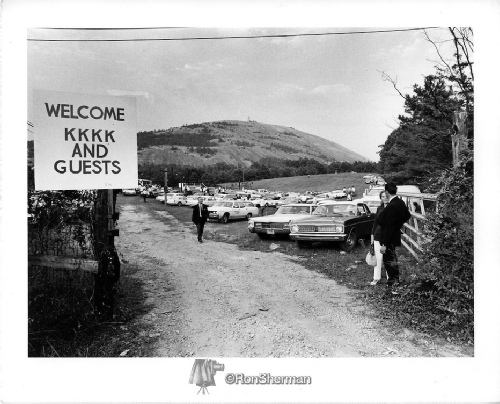
So what was MLK's dream about Stone Mountain in 1963?
I have a dream today!
I have a dream that one day every valley shall be exalted, and every hill and mountain shall be made low, the rough places will be made plain, and the crooked places will be made straight; "and the glory of the Lord shall be revealed and all flesh shall see it together."
This is our hope, and this is the faith that I go back to the South with.
With this faith, we will be able to hew out of the mountain of despair a stone of hope. With this faith, we will be able to transform the jangling discords of our nation into a beautiful symphony of brotherhood. With this faith, we will be able to work together, to pray together, to struggle together, to go to jail together, to stand up for freedom together, knowing that we will be free one day.
And this will be the day -
My country 'tis of thee, sweet land of liberty, of thee I sing.
Land where my fathers died, land of the Pilgrim's pride,
From every mountainside, let freedom ring!
And if America is to be a great nation, this must become true.
And so let freedom ring from the prodigious hilltops of New Hampshire.
Let freedom ring from the mighty mountains of New York.
Let freedom ring from the heightening Alleghenies of Pennsylvania.
Let freedom ring from the snow-
Let freedom ring from the curvaceous slopes of California.
But not only that:
Let freedom ring from Stone Mountain of Georgia.
Let freedom ring from Lookout Mountain of Tennessee.
Let freedom ring from every hill and molehill of Mississippi.
From every mountainside, let freedom ring.
And when this happens, and when we allow freedom ring, when we let it ring from every village and every hamlet, from every state and every city, we will be able to speed up that day when all of God's children, black men and white men, Jews and Gentiles, Protestants and Catholics, will be able to join hands and sing in the words of the old Negro spiritual:
Free at last! Free at last!
Thank God Almighty, we are free at last!
That was over 50 years ago. So…how’s the hand-
Have a look at a short video filmed on a night in 2009 at Stone Mountain. No, not at the Amusement Park. The area is big enough to allow… private parties in hidden hollows.
Sorry, Mr. King. Not yet.